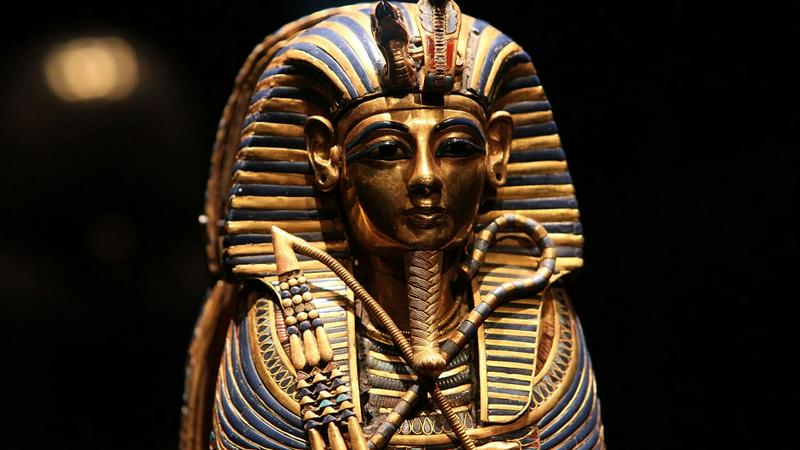King Tut Fever Of The 1970s Was PR For A Middle East Treaty
By | October 3, 2019

The exhibition of the tomb of Kink Tutankhamun -- "King Tut" -- in the 1970s was a museum phenomenon unlike any the world had seen. King Tut and the associated artifacts weren't a new discovery, but their voyage to the U.S. and display in major cities whipped up tremendous public excitement. Certainly, for an exhibition of ancient things dug out of the ground, the touring King Tut show was a success beyond all expectation -- but was it really just about King Tut? Though museum-goers might not have known it, the political situation of the day -- involving President Richard Nixon, Egypt, and the larger scenario of the Middle East -- had made this thing happen.
In 1922, the archaeologist Howard Carter discovered King Tut’s tomb. This spawned a cultural craze in the ‘20s and ‘30s, and the impact of the fascination with all things Egypt could be seen in music, film, fine art, and even furniture design.
King Tut Becomes Political

1974 marked the restoration of diplomatic relations between the U.S. and Egypt. For Nixon, the King Tut exhibit became PR, since Nixon and Kissinger were trying to change the American perception of Egypt. In June of 1974, Nixon rode alongside Sadat on a train from Cairo to Alexandria. Starting in the fall of 1974, the U.S. and Egypt negotiated an agreement that included a cultural clause in which the U.S. would help restore the Cairo Opera House and Egypt would send the "Treasures of Tutankhamun" to America. The Tut exhibition was slated to begin in 1976, the U.S. bicentennial year. Prior to the Sadat-Nixon agreement, the National Gallery of Art in Washington D.C. had arranged for its own Tut exhibit in 1977 or 1978. J. Carter Brown, the director of the National Gallery, offered the National Gallery’s services to organize the exhibition.
The director of the Metropolitan Museum of Art, Thomas Hoving, was also vying to organize the exhibition. Hoving and Brown had a long-standing rivalry, and after Brown organized “The Archaeological Treasures of the People’s Republic of China,” Hoving became determined to organize the Tut exhibit. Eventually, Hoving won, and an agreement was reached. The exhibit would begin at The National Gallery and close in New York, and the Met did not get credit as the exhibit’s initiator.
Bringing King Tut To America

In addition to D.C. and New York, the “Treasures of Tutankhamun” traveled to New Orleans, Chicago, Seattle, and Los Angeles. This was another political victory for Nixon since the exhibit visited six American cities and only four Soviet cities.
But the exhibit faced another challenge: exorbitant insurance costs. This problem was eliminated when Congress passed the Arts and Artifacts Indemnity Act which helped with the insurance costs of international exhibitions; the act passed in 1975, just in time. Additional funding came from NEH grants.
They then had a year to organize, choosing the 55 objects to be included, photographing them and composing the text for the catalog. From there, the U.S. Navy transported the objects from Egypt, stopping first in Naples, Italy to hand off the objects to another naval ship which delivered them to Norfolk, Virginia.
Different Cities, Slightly Different Exhibitions

The museums had some free rein in arranging the exhibition. They were bound to rely on using the same text and photographs and to develop their displays around the layout of the tomb. The National Gallery created a minimalist display, showcasing the objects against the walls, while the Met recreated Tut’s tomb. The exhibition did not include Tut’s sarcophagus, but it did have items from his burial chamber, including his funeral mask.
By the time the exhibit closed at the National Gallery on March 15, more than 835,000 people had visited, including politicians and celebrities. Jimmy Carter attended, as did Andy Warhol. The floors were damaged, and visitors spent more than $100,000 per week on souvenirs. Profits from the sale of souvenirs went to the Egyptian Organization of Antiquities.
The Show Had Some Interesting Repercussions

The next stop was Chicago, where the Field Museum of Natural History had upgraded its switchboard and security and devised a new ticket system. The furor continued there, where people began lining up at 5 a.m. To signal ticket availability, the museum flew a flag on the building and when tickets were no longer available for the day, the flag was lowered to half-mast.
It moved on to New Orleans, where even Bourbon Street got in on the celebration. To send off the exhibition, the museum hosted a jazz funeral for Tut. It then moved on to Los Angeles and Seattle.
Even SNL Got In On It

The final stop was New York, where the lines for tickets stretched for 23 blocks down 5th Avenue. As it came to an end, Steve Martin appeared on Saturday Night Live, singing his song “King Tut” and bemoaning the way that the show commercialized King Tut. The exhibit, begun as part of Nixon’s political maneuverings, had become a moneymaker for the museums, souvenir manufacturers, and local economies. And it had outlived Nixon's presidency -- the New York leg of the tour occurred in 1978, four years after Tricky Dick had resigned. The exhibit did have some positive effects: it led to new ticketing systems, higher standards for future shows, and, perhaps most importantly, 9 million dollars raised for the Egyptian government to fund renovations to the Cairo Museum.
